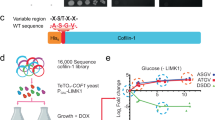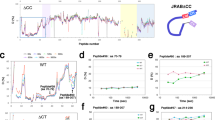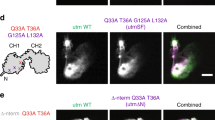Abstract
The crystal structure of the core domain (N-terminal 30 kDa domain) of cytoskeletal protein 4.1R has been determined and shows a cloverleaf-like architecture. Each lobe of the cloverleaf contains a specific binding site for either band 3, glycophorin C/D or p55. At a central region of the molecule near where the three lobes are joined are two separate calmodulin (CaM) binding regions. One of these is composed primarily of an α-helix and is Ca2+ insensitive; the other takes the form of an extended structure and its binding with CaM is dramatically enhanced by the presence of Ca2+, resulting in the weakening of protein 4.1R binding to its target proteins. This novel architecture, in which the three lobes bind with three membrane associated proteins, and the location of calmodulin binding sites provide insight into how the protein 4.1R core domain interacts with membrane proteins and dynamically regulates cell shape in response to changes in intracellular Ca2+ levels.
This is a preview of subscription content, access via your institution
Access options
Subscribe to this journal
Receive 12 print issues and online access
$189.00 per year
only $15.75 per issue
Buy this article
- Purchase on Springer Link
- Instant access to full article PDF
Prices may be subject to local taxes which are calculated during checkout




Similar content being viewed by others
Accession codes
References
Conboy, J.G. Semin. Hematol. 30, 58–73 (1993).
Parra, M., et al. J. Biol. Chem. 275, 3247– 3255 (2000).
Marfatia, S.M., Lue, R.A., Branton, D. & Chishti, A. H. J. Biol. Chem. 270, 715–719 ( 1995).
Nunomura, W., Takakuwa, Y., Parra, M., Conboy, J. & Mohandas, N. J. Biol. Chem. 275, 24540– 24546 (2000).
Pasternack, G.R., Anderson, R.A., Leto, T.L. & Marchesi, V.T. J. Biol. Chem. 260, 3676–3683 (1985).
Gould, K.L., Bretscher, A., Esch, F.S. & Hunter, T. EMBO J. 8, 4133–4142 ( 1989).
Takakuwa, Y. & Mohandas, N. J. Clin. Invest. 82 , 394–400 (1988).
Ikura, M., Clore, G.M., Gronenborn, A.M., Zhu, G., Klee, C.B. & Bax, A. Science 256, 632–638 ( 1992).
Meador, W.E., Means, A.R. & Quiocho, F.A. Science 257, 1251– 1255 (1992).
Meador, W.E., Means, A.R. & Quiocho, F.A. Science 262, 1718– 1721 (1993).
Osawa, M., et al. Nature Struct. Biol. 6, 819– 824 (1999).
Dasgupta, M., Honeycutt, T. & Blumenthal, D.K. J. Biol. Chem. 264, 17156– 17163 (1989).
Zhou, N., Yuan, T., Mak, A.S. & Vogel, H.J. Biochemistry 36, 2817–2825 (1997).
Goldberg, J., Nairn, A.C. & Kuriyan, J. Cell 84, 875– 887 (1996).
Nunomura, W., Takakuwa, Y., Parra, M., Conboy, J.G. & Mohandas, N. J. Biol. Chem. 275, 6360– 6367 (2000).
Jöns, T. & Drenckhahn, D. EMBO J. 11, 2863–2867 (1992).
Han, B.-G., Nunomura, W., Wu, H., Mohandas, N. & Jap, B.K. Acta Crystallogr. D 56, 187– 188 (2000).
Hendrickson, W.A., Horton, J.R. & LeMaster, D.M. EMBO J. 9, 1665– 1672 (1990).
Otwinoski Z. & Minor, W. Methods Enzymol. 276, 307–326 (1997).
Terwilliger, T. C. Acta Crystallogr. D 50, 17–23 (1994).
Collaborative Computational Project, Number 4. Acta Crystallogr. D 50, 760–763 (1994).
Jones, T.A., Zou, J.-Y. & Cowan, S. W. Acta Crystallogr. A 47, 110– 119 (1991).
Brünger, A.T., et al. Acta Crystallogr. D 54, 905– 921 (1998).
Acknowledgements
This work was supported by the Director, Office of Science, Office of Biological and Environment Research, Life Sciences Division, of the U.S. Department of Energy (DOE), by National Institutes of Health (NIH) Research grants and by the Ministry of Education of Japan. We also thank the staff at the ALS beam line 5.0.2 and the NSLS beam line X25 for their assistance during data collection. The synchrotron facilities are supported by DOE (ALS and NSLS) and NIH (NSLS). We are thankful to P.J. Walian for helpful discussions and critical reading of the manuscript.
Author information
Authors and Affiliations
Corresponding authors
Rights and permissions
About this article
Cite this article
Han, BG., Nunomura, W., Takakuwa, Y. et al. Protein 4.1R core domain structure and insights into regulation of cytoskeletal organization. Nat Struct Mol Biol 7, 871–875 (2000). https://doi.org/10.1038/82819
Received:
Accepted:
Issue Date:
DOI: https://doi.org/10.1038/82819
This article is cited by
-
4.1B suppresses cancer cell proliferation by binding to EGFR P13 region of intracellular juxtamembrane segment
Cell Communication and Signaling (2019)
-
Unique Structural Changes in Calcium-Bound Calmodulin Upon Interaction with Protein 4.1R FERM Domain: Novel Insights into the Calcium-dependent Regulation of 4.1R FERM Domain Binding to Membrane Proteins by Calmodulin
Cell Biochemistry and Biophysics (2014)
-
A member of the Plasmodium falciparum PHIST family binds to the erythrocyte cytoskeleton component band 4.1
Malaria Journal (2013)
-
Novel Mechanism of Regulation of Protein 4.1G Binding Properties Through Ca2+/Calmodulin-Mediated Structural Changes
Cell Biochemistry and Biophysics (2013)
-
The spectrin–ankyrin–4.1–adducin membrane skeleton: adapting eukaryotic cells to the demands of animal life
Protoplasma (2010)



